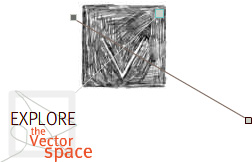Dead Reckoning
Aerial Perception and the Social Construction of Targets
Design by Raegan Kelly
Editor's Introduction
I recently learned to fly. Not in a plane but superman-like, zooming through space, arms stretched out to catch the air, or, more accurately, the abstracted pixels that comprise the god-view in the popular online world of Second Life. Flying did not come naturally to me (I'm prone to motion sickness when images race by), but, with practice, I soon came to enjoy my time 'above' and began to hover in the sky with frequency. Of course, my computer had begun to train me for such modes of viewing long before I dressed up my avatar and started collecting Linden dollars. My desktop sports an aerial image of the roof of my house, courtesy of Zillow. Rarely a week passes that I don't zoom in and out of a Google map, navigating scale with ease. Various computer games have habituated me to an easy transit from micro to macro. In short, I've grown accustomed to the god view and can easily inhabit its perspective.
"Dead Reckoning" seeks to demystify this aerial view, carefully revealing its mediated and constructed nature as well as its long history. As Caren Kaplan reminds us within the piece, the development of perspective during the European Renaissance re-ordered the visual field. The piece not only tracks the techniques and technologies utilized to render perspective and vision, particularly as deployed by the military; it also insists that these modes of vision are never neutral, never simply "discovered." Indeed, the uses of perspective and of aerial vision track quite closely to the histories of empire and colonization, revealing telling feedback loops between modes of perception and the ascendancy of the nation state.
If visual studies has now attuned the scholar to the politics of vision, the particular brilliance of this piece is its experiential dimension. Rather than fetishize the aerial view, the design of the project continually foregrounds the highly artificial nature of seeing from above, subtly interrupting a "perfect" view with blocks of scrolling, mobile text. In some moments, multiple windows appear, blocking the view entirely, demanding that the user engage (or at least minimize) the analysis in order to create a "better" view. The interface intentionally confounds the easy ability to see everything or to move easily between zones. Rather than sustain the dream of perfect transparency that so fuels commercial interface design, "Dead Reckoning" subtly foregrounds the presence of the machine and the program. Images in the piece are rarely pristine or clear, not by error but by design and with intention, leading us to question the relationship between what we (imagine we) see and what we (think we) know. As such, the project asks us to interrogate the very conditions of visibility that enable our experience of daily life, helping us to perceive the ideological stakes of perception itself.
As the user navigates through the piece, manipulating eyeballs, targets, tiny planes, and pixels, her perceptual capacity is re-skilled and refined, allowing her to better understand the technological camouflage that so intricately guides our contemporary ways of seeing. Patience and engagement are rewarded, unfolding new layers of meaning and text, underscoring that there is more here than at first meets the eye. We are reminded that sight is never natural, that perspective is always political, and that the ability to zoom through landscapes or to designate borders is unevenly distributed, enabled by vast networks of power that we would do well to remember and question.



